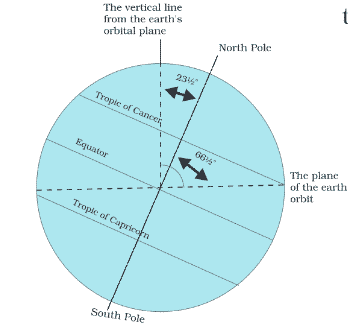Class 6- Geography Chapter 3
Contents
- The Earth has two types of motions: Rotation and Revolution
Rotation
- The movement of the Earth on its axis.
- The Earth takes about 24 hours to complete one rotation around its axis. The period of rotation is known as the Earthday.
- What would happen if the Earth did not rotate?
The portion of the Earth facing the sun would always experience day, thus bringing continuous warmth to the region. The other half would remain in darkness and be freezing cold all the time. Life would not have been possible in such extreme conditions.
Revolution
- The movement of the Earth around the sun in a fixed path or elliptical orbit.
- It takes 365 days and 6 hours to revolve around the sun.
- 365 days are counted as one year and 6 hours saved every year are added to make one day (24 hours) over a span of four years.
- This extra day is added to the month of February and such a year with 366 days is called a Leap Year.
- Throughout its orbit, the Earth remains inclined in the same direction.
- Axis- The axis of the Earth is an imaginary line. It makes an angle of 66.5º with the Earth’s orbital plane (plane formed by the orbit).

- Circle of Illumination: The Earth receives light from the sun. Due to the spherical shape of the Earth, only half of it gets light from the sun at a time. The portion facing the Sun experiences day while the other half away from the sun experiences night. The circle that divides the day from night on the globe is called the circle of illumination. It does not coincide with the axis.
Revolution of the Earth and Seasons
- A year is divided into summer, winter, spring and autumn seasons. Seasons change due to the change in the position of the Earth around the sun.
- On 21st June, the Northern Hemisphere is tilted towards the sun. The rays of the sun fall directly on the Tropic of Cancer. Hence, these areas receive more heat.
- The areas near the poles receive less heat as the rays of the sun are slanting.
- The North Pole is inclined towards the sun and the places beyond the Arctic Circle experience continuous daylight for about six months.
- Since, a large portion of the Northern Hemisphere is getting light from the sun, it is summer in the regions north of the equator.
- The longest day and the shortest night at these places occur on 21st June.
- At this time in the Southern Hemisphere all these conditions are reversed. It is winter season there.
- This position of the Earth is called the Summer Solstice.
- On 22nd December, the Tropic of Capricorn receives direct rays of the sun as the South Pole tilts towards it.
- As the sun’s rays fall vertically at the Tropic of Capricorn, a larger portion of the southern Hemisphere gets light.
- Therefore, it is summer in the Southern Hemisphere with longer days and shorter nights.
- The reverse happens in the Northern Hemisphere.
- This position of the Earth is called the Winter Solstice.
- On 21st March and 23rd September, direct rays of the sun fall on the equator.
- At this position, neither of the poles is tilted towards he sun, so the whole Earth experiences equal days and equal nights.
- This is called an Equinox.
- On 23rd September, it is autumn season in the Northern Hemisphere and spring season in the Southern Hemisphere.
- The opposite is the case on 21st March, when it is spring in the Northern Hemisphere and autumn in the Southern Hemisphere.
Thus, there are days and nights and changes in the seasons because of the rotation and revolution of the earth respectively.












